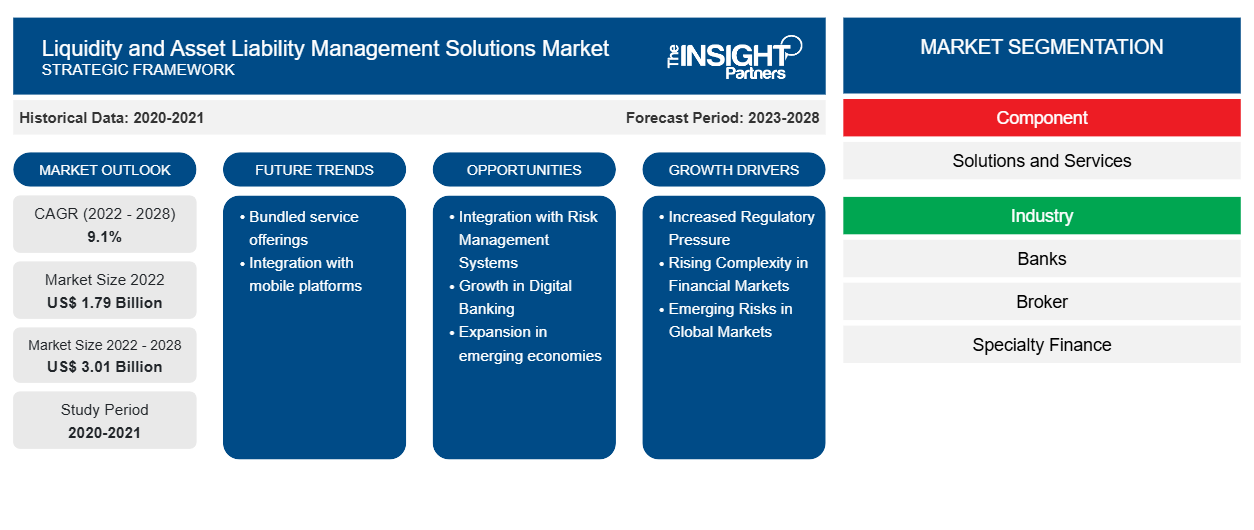流动性和资产负债管理解决方案市场规模预计将从 2022 年的 17.8759 亿美元增长到 2028 年的 30.0924 亿美元;预计从 2022 年到 2028 年的复合年增长率为 9.1%。
流动性管理是指机构确保拥有足够的现金和流动资产以支付机构费用并满足客户贷款或储蓄提取需求的行为。资产负债管理是规划、组织和控制资产和负债数量、期限、利率和收益的过程,以尽量降低利率风险并保持可接受的盈利水平。流动性和资产负债管理解决方案和服务可帮助企业有效地管理流动性和资产负债。
监管日益严格和对利率风险的日益关注,迫使银行机构寻求全面的流动性和资产负债管理解决方案。银行账簿利率风险 (IRRBB) 和融资规划下的 EBA 压力测试是一些因素,要求银行评估利率上升、利率敏感资产价值变化以及监管资本随之下降的可能后果。此外,BFSI 部门一直在见证与风险管理相关的法规不断增加。此外,美国、英国、瑞士、日本和其他大型银行业国家的利率持续波动,降低了 BFSI 部门的利润率。这些因素促进了全球流动性和资产负债管理解决方案市场的增长。这些解决方案和服务可以让金融机构根据情景分析做出决策,从风险和财务角度提供更好的视角,并有力地帮助企业遵守监管要求。大多数现代流动性和资产负债解决方案都集成了资金转移定价 (FTP),允许用户区分一项活动与另一项活动的盈利能力。
根据流动性和资产负债管理解决方案市场报告,流动性和资产负债管理解决方案市场分为组件和行业。根据组件,流动性和资产负债管理解决方案市场分为解决方案和服务。根据行业,流动性和资产负债管理解决方案市场分为银行、经纪人、专业金融、财富顾问和其他。
定制此报告以满足您的需求
您可以免费定制任何报告,包括本报告的部分内容、国家级分析、Excel 数据包,以及为初创企业和大学提供优惠和折扣
- 获取此报告的关键市场趋势。这个免费样品将包括数据分析,从市场趋势到估计和预测。
COVID-19 疫情对流动性和资产负债管理解决方案市场规模的影响
随着各国为应对 COVID-19 疫情而实施的社会限制,BFSI 行业的主要利益相关者(如银行、经纪人和财富顾问)转向数字平台来满足他们的日常需求。在这种情况下,数字钱包(通常称为电子钱包)变得越来越受欢迎。由于这种转变,信贷损失和不良资产 (NPA) 的可能性增加,而银行经历了意外的资产负债管理 (ALM) 模型结果。金融行动特别工作组 (FATF) 已警告银行注意非法货币交易。因此,对流动性和资产负债管理解决方案的需求激增,极大地影响了流动性和资产负债管理解决方案市场的增长。此外,由于数字平台的广泛使用,网络上的数据量正在增长,给银行和金融机构及时维护资产负债表带来了很大压力。由于贷款再融资增加,大多数地区和国际银行的贷款收益率和利润率都远低于预期。COVID-19 疫情加速了数字技术和数字流动性的发展。因此,银行和金融机构现在正在使用数据分析技术来改进其资产管理流程。
市场洞察 – 流动性和资产负债管理解决方案市场分析
BNPL 行业的增长
渐进式先买后付 (BNPL) 行业也支持流动性和资产负债管理解决方案市场的增长。有效的信用风险和负债管理是 BNPL 参与者成功的关键。根据 Apptopia 的报告,BNPL 应用程序下载量在 2021 年 11 月达到 680 万次,比 2020 年 11 月增长 54%,月活跃用户 (MAU) 同比增长 63%。尽管美国处于领先地位,但欧洲的活跃用户数量也大幅增长。根据 PayU 的报告,2020 年欧洲 7.4% 的电子商务交易总额使用 BNPL 服务进行,预计未来五年交易数量将增长 45%。因此,随着全球 BNPL 行业的蓬勃发展,再加上行业参与者对负债风险的日益关注,流动性和资产负债管理解决方案市场预计在预测期内将以良好的速度增长。
基于组件的流动性和资产负债管理解决方案市场洞察
根据组成部分,流动性和资产负债管理解决方案市场分为解决方案和服务。解决方案部分预计将成为增长最快的部分,主要受到人工智能解决方案的推动。服务部分预计将在预测期内以中等速度增长。
基于最终用户的流动性和资产负债管理解决方案市场洞察
从行业来看,全球流动性和资产负债解决方案市场分为银行、经纪商、专业金融、财富顾问等。由于流动性和资产负债解决方案在全球范围内得到广泛采用,预计银行部门将成为预测期内最大的部门。
流动性和资产负债管理解决方案市场参与者主要致力于开发先进、高效的产品。以下列举几个例子。
- 2022 年 6 月,Infosys Finacle(EdgeVerve Systems 的一部分,Infosys 和 Suryoday Small Finance Bank (SSFB) 的全资子公司)宣布成功实施 Finacle Core Banking Platform 和 Finacle Treasury Platform。Finacle 将在 IBM 基础架构堆栈支持的内部部署模型中支持 SSFB 的零售、企业和支付引擎。
- 2022 年 2 月,数据分析和人工智能技术巨头 SAS 收购了总部位于檀香山的 Kamakura Corp.,这将扩大其在金融服务行业的影响力,并扩大 SAS 的金融风险管理软件产品组合。它是数据分析和数据管理领域的领先公司之一。
流动性和资产负债管理解决方案市场区域洞察
Insight Partners 的分析师已详细解释了预测期内影响流动性和资产负债管理解决方案市场的区域趋势和因素。本节还讨论了北美、欧洲、亚太地区、中东和非洲以及南美和中美洲的流动性和资产负债管理解决方案市场细分和地理位置。

- 获取流动性和资产负债管理解决方案市场的区域特定数据
流动性和资产负债管理解决方案市场报告范围
| 报告属性 | 细节 |
|---|---|
| 2022 年市场规模 | 17.9亿美元 |
| 2028 年市场规模 | 30.1亿美元 |
| 全球复合年增长率(2022 - 2028) | 9.1% |
| 史料 | 2020-2021 |
| 预测期 | 2023-2028 |
| 涵盖的领域 | 按组件
|
| 覆盖地区和国家 | 北美
|
| 市场领导者和主要公司简介 |
|
市场参与者密度:了解其对商业动态的影响
流动性和资产负债管理解决方案市场正在快速增长,这得益于最终用户需求的不断增长,而这些需求又源于消费者偏好的不断变化、技术进步以及对产品优势的认识不断提高等因素。随着需求的增加,企业正在扩大其产品范围,进行创新以满足消费者的需求,并利用新兴趋势,从而进一步推动市场增长。
市场参与者密度是指在特定市场或行业内运营的企业或公司的分布情况。它表明在给定市场空间中,相对于其规模或总市场价值,有多少竞争对手(市场参与者)存在。
在流动性和资产负债管理解决方案市场运营的主要公司有:
- Experian Information Softwares, Inc.
- 富达国家信息服务有限公司
- 菲纳斯特拉国际有限公司
- IBM 公司
- 印孚瑟斯公司
免责声明:上面列出的公司没有按照任何特定顺序排列。

- 获取流动性和资产负债管理解决方案市场顶级关键参与者概览
公司简介:流动性和资产负债管理解决方案市场
- Experian 信息软件有限公司
- 富达国家信息服务有限公司
- 菲纳斯特拉国际有限公司
- IBM 公司
- 印孚瑟斯公司
- 智力设计竞技场有限公司
- 穆迪公司
- 甲骨文公司
- 思爱普
- 荷兰威科集团
- 历史分析(2 年)、基准年、预测(7 年)及复合年增长率
- PEST 和 SWOT 分析
- 市场规模价值/数量 - 全球、区域、国家
- 行业和竞争格局
- Excel 数据集



Report Coverage
Revenue forecast, Company Analysis, Industry landscape, Growth factors, and Trends

Segment Covered
This text is related
to segments covered.

Regional Scope
North America, Europe, Asia Pacific, Middle East & Africa, South & Central America

Country Scope
This text is related
to country scope.
常见问题
The incremental growth, expected to be recorded for the liquidity and asset liability management solutions market during the forecast period, is US$ 1,221.66 million.
The solutions led the liquidity and asset liability management solutions market with a significant share in 2021.
The liquidity and asset liability management solutions market is expected to reach US$ 3,009.24 million by 2028.
Asia Pacific is the fastest growing regional market, followed by North America.
China, India, Japan, and the US are expected to register high growth rates during the forecast period.
The US held the largest market share in 2021, followed by China.
The key players, holding majority shares, in liquidity and asset liability management solutions market includes Fidelity National Information Services, Inc., Moody's Corporation, Oracle Corporation, Wolters Kluwer N.V., and Finastra International Limited.
Growing integration of AI and analytics into liquidity and asset liability management solutions is expected to play a crucial role in the future of the liquidity and asset liability management solutions market. AI is being integrated extensively across numerous areas, from cloud computing applications to digital assistants, to automate the process.
Liquidity and asset liability management solutions market is being driven by the increasing credit risk across financial institutions. The banking and financial industry experienced severe disruptions in 2020 and 2021 after the onset of the COVID-19 pandemic. This provides growth opportunities for liquidity and asset liability management solution providers.
The global liquidity and asset liability management solutions market was estimated to be USD 1,661.64 million in 2021 and is expected to grow at a CAGR of 9.1%, during the forecast period 2022 - 2028.
Trends and growth analysis reports related to Technology, Media and Telecommunications : READ MORE..
The List of Companies - Liquidity and Asset Liability Management Solutions Market
- Experian Information Softwares, Inc.
- Fidelity National Information Services, Inc.
- Finastra International Limited
- IBM Corporation
- Infosys, Ltd.
- Intellect Design Arena Limited
- Moody's Corporation
- Oracle Corporation
- SAP SE
- Wolters Kluwer N.V.
The Insight Partners performs research in 4 major stages: Data Collection & Secondary Research, Primary Research, Data Analysis and Data Triangulation & Final Review.
- Data Collection and Secondary Research:
As a market research and consulting firm operating from a decade, we have published and advised several client across the globe. First step for any study will start with an assessment of currently available data and insights from existing reports. Further, historical and current market information is collected from Investor Presentations, Annual Reports, SEC Filings, etc., and other information related to company’s performance and market positioning are gathered from Paid Databases (Factiva, Hoovers, and Reuters) and various other publications available in public domain.
Several associations trade associates, technical forums, institutes, societies and organization are accessed to gain technical as well as market related insights through their publications such as research papers, blogs and press releases related to the studies are referred to get cues about the market. Further, white papers, journals, magazines, and other news articles published in last 3 years are scrutinized and analyzed to understand the current market trends.
- Primary Research:
The primarily interview analysis comprise of data obtained from industry participants interview and answers to survey questions gathered by in-house primary team.
For primary research, interviews are conducted with industry experts/CEOs/Marketing Managers/VPs/Subject Matter Experts from both demand and supply side to get a 360-degree view of the market. The primary team conducts several interviews based on the complexity of the markets to understand the various market trends and dynamics which makes research more credible and precise.
A typical research interview fulfils the following functions:
- Provides first-hand information on the market size, market trends, growth trends, competitive landscape, and outlook
- Validates and strengthens in-house secondary research findings
- Develops the analysis team’s expertise and market understanding
Primary research involves email interactions and telephone interviews for each market, category, segment, and sub-segment across geographies. The participants who typically take part in such a process include, but are not limited to:
- Industry participants: VPs, business development managers, market intelligence managers and national sales managers
- Outside experts: Valuation experts, research analysts and key opinion leaders specializing in the electronics and semiconductor industry.
Below is the breakup of our primary respondents by company, designation, and region:

Once we receive the confirmation from primary research sources or primary respondents, we finalize the base year market estimation and forecast the data as per the macroeconomic and microeconomic factors assessed during data collection.
- Data Analysis:
Once data is validated through both secondary as well as primary respondents, we finalize the market estimations by hypothesis formulation and factor analysis at regional and country level.
- Macro-Economic Factor Analysis:
We analyse macroeconomic indicators such the gross domestic product (GDP), increase in the demand for goods and services across industries, technological advancement, regional economic growth, governmental policies, the influence of COVID-19, PEST analysis, and other aspects. This analysis aids in setting benchmarks for various nations/regions and approximating market splits. Additionally, the general trend of the aforementioned components aid in determining the market's development possibilities.
- Country Level Data:
Various factors that are especially aligned to the country are taken into account to determine the market size for a certain area and country, including the presence of vendors, such as headquarters and offices, the country's GDP, demand patterns, and industry growth. To comprehend the market dynamics for the nation, a number of growth variables, inhibitors, application areas, and current market trends are researched. The aforementioned elements aid in determining the country's overall market's growth potential.
- Company Profile:
The “Table of Contents” is formulated by listing and analyzing more than 25 - 30 companies operating in the market ecosystem across geographies. However, we profile only 10 companies as a standard practice in our syndicate reports. These 10 companies comprise leading, emerging, and regional players. Nonetheless, our analysis is not restricted to the 10 listed companies, we also analyze other companies present in the market to develop a holistic view and understand the prevailing trends. The “Company Profiles” section in the report covers key facts, business description, products & services, financial information, SWOT analysis, and key developments. The financial information presented is extracted from the annual reports and official documents of the publicly listed companies. Upon collecting the information for the sections of respective companies, we verify them via various primary sources and then compile the data in respective company profiles. The company level information helps us in deriving the base number as well as in forecasting the market size.
- Developing Base Number:
Aggregation of sales statistics (2020-2022) and macro-economic factor, and other secondary and primary research insights are utilized to arrive at base number and related market shares for 2022. The data gaps are identified in this step and relevant market data is analyzed, collected from paid primary interviews or databases. On finalizing the base year market size, forecasts are developed on the basis of macro-economic, industry and market growth factors and company level analysis.
- Data Triangulation and Final Review:
The market findings and base year market size calculations are validated from supply as well as demand side. Demand side validations are based on macro-economic factor analysis and benchmarks for respective regions and countries. In case of supply side validations, revenues of major companies are estimated (in case not available) based on industry benchmark, approximate number of employees, product portfolio, and primary interviews revenues are gathered. Further revenue from target product/service segment is assessed to avoid overshooting of market statistics. In case of heavy deviations between supply and demand side values, all thes steps are repeated to achieve synchronization.
We follow an iterative model, wherein we share our research findings with Subject Matter Experts (SME’s) and Key Opinion Leaders (KOLs) until consensus view of the market is not formulated – this model negates any drastic deviation in the opinions of experts. Only validated and universally acceptable research findings are quoted in our reports.
We have important check points that we use to validate our research findings – which we call – data triangulation, where we validate the information, we generate from secondary sources with primary interviews and then we re-validate with our internal data bases and Subject matter experts. This comprehensive model enables us to deliver high quality, reliable data in shortest possible time.


 获取此报告的免费样本
获取此报告的免费样本